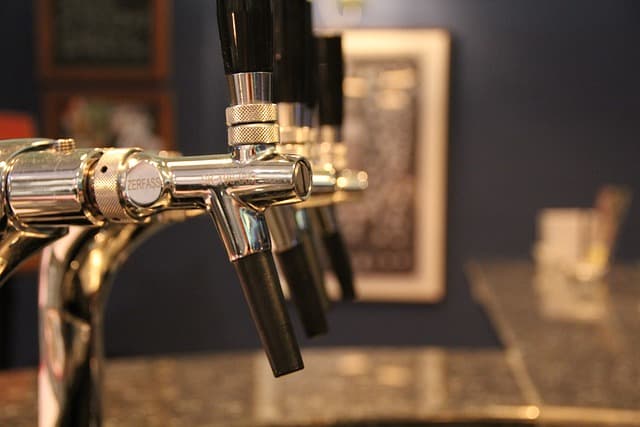Schlossbrauerei Stein is located 90 km east of Munich in Stein an der Traun, a town of about 4,000 people. The nearest “big” city is Traunreuth, 5 km away, with just over 20,000 inhabitants. At first glance, Stein Brewery is a typical German regional brewery, selling beer within a radius of only 40 km (from the “Bavarian sea” – Lake Kimsee – to the Austrian border). But one peculiarity makes this brewery very interesting.
Schlossbrauerei Stein brewery is located on the grounds of a “cave castle” that has existed since the 12th century. It is a rare type of castle, which is “embedded” in the rock, making it impregnable from at least three sides. The legendary robber baron Heinz of Stein, who terrified passing merchants, lived here in the 13th century.
The first mention of a brewery in the castle dates back to 1489 (530 years ago!).
In the 19th century the castle belonged to the Duchess of Leuchtenberg, daughter of Napoleon Bonaparte’s stepson.
The location of the castle in the rock has been used to their advantage by brewers in the past: the constant low temperature inside the rock made it possible to brew beer even in the warm season. This peculiarity is used even nowadays: the forfs located in the cave require considerably less energy for cooling.
Traditional brewing and Steiner VS Warsteiner
Beer is brewed by decoction on a brewhouse with a capacity of 300 hl per brew. Up to seven brewings per week, with no more than one brew per day.
Schlossbrauerei Stein produces about 60,000 hl of beer per year, which is sold exclusively within the district. Approximately 70% of the beer is sold in bottle and 30% is sold in kegs. 90% of the beer is filtered (almost all bottled beer).
The cavernous brewery has a wide lineup of brews:
- Steiner Pils – Pilsner (ext. 11.8%, alk. 4.8%).
- Steiner Export (12.5% ext., alk. 5.3%).
- Steiner Medium – Low-Alcohol Beer (ext. 7.2%, alk. 3.2%).
- Steiner Märzenbier – Merzen (13.0% alcohol, 5.5%).
- Steiner Chiemgau Helles – Helles from locally brewed (11.5% extract, 4.9% alk).
- Steiner Chiemgau Urdunkel – a dark beer made according to the recipes of the Benedictine monks from the Seeon monastery on Lake Kimsee (12.4% ext., alk. 5.2%).
- Heinz vom Steiner Helles Weissbier, Bio-bier is a Bavarian light wheat bio-beer (11.7% ext., alk. 4.9%).
- Heinz vom Steiner Dunkles Weissbier, Bio-bier – Bavarian dark wheat bio-beer (11.8% ext., alk. 4.9%).
- Heinz vom Steiner Lagerbier is an unfiltered Zwickel-style beer with suspended yeast (ext. 12.7%, alk. 5.3%).
There are also two non-alcoholic beers (bottom and top fermentation), a radler and several seasonal beers (e.g. Steinbock, a strong dark beer with 18.5% alk).
Not so long ago the brewery had an opportunity to start selling beer in Italy, but it turned out that it was impossible to sell beer under the Steiner brand there – it violates the rights of Warsteiner – the largest private German brewery in the Italian market, because the word Steiner contains part of the word Warsteiner.
“Classic” and CKT
All bottom-fermented beers are produced according to the “classic” scheme with two tanks. The lager house has a common refrigeration system. Because of the height, the fermentation tanks could not be placed in the rock and the cooling costs could not be reduced. But the horizontal forfs of enormous length fit well in the same cave where beer barrels were stored in the old days.
It may seem strange that the bottom beers are fermented in the old fashioned way, while the top beers are fermented in a CKT. But there is an explanation: it was technologically necessary to separate the production of Weissbier from the general fermentation process and for the expansion the more modern and less labor-intensive CKTs were preferred.
Raw materials
The malt is stored in wooden silos, which also serve as supporting structures in the brewery (so they are not easily discarded).
The brewery uses Pappenheimer malz malt from a malt house located in Middle Franconia. Pappenheimer produces four varieties: Pilsner, Weizen, Munchner and Wiener, which are the main malts for the Schlossbrauerei Stein brewery.
The yeast for the main beers of the bottom-fermented “cave brewery” is the well-known W-34/70. For Bavarian wheat beer, the W-68 strain is used.
Energy
In addition to the location of part of the equipment in the rock, Schlossbrauerei Stein has another advantage: its own small hydroelectric power plant, which covers the brewery’s energy needs. The dam is located on the site of an old water mill on the branch of the river Traun, a tributary of the Danube. Trout frolic in the clear water from the alpine slopes. This water was once also used for brewing beer, but now the brewery is supplied from a well.
Bottling
The beer can either go straight to the filler after filtration or wait in the buffer tank for bottling. The filter has a capacity of 10,000 liters per hour.
Bottling and keg bottling, as well as palletizing of the bottles, take place on fully automated lines. Like most German breweries, Schlossbrauerei Stein uses reusable bottles.
In Germany, especially in its southern part, there are a lot of so-called “breweries around the bell tower,” selling beer only in their town and neighboring villages. Schlossbrauerei Stein is one of many regional breweries. But the “cavernous” aging of the beer makes it unique.
